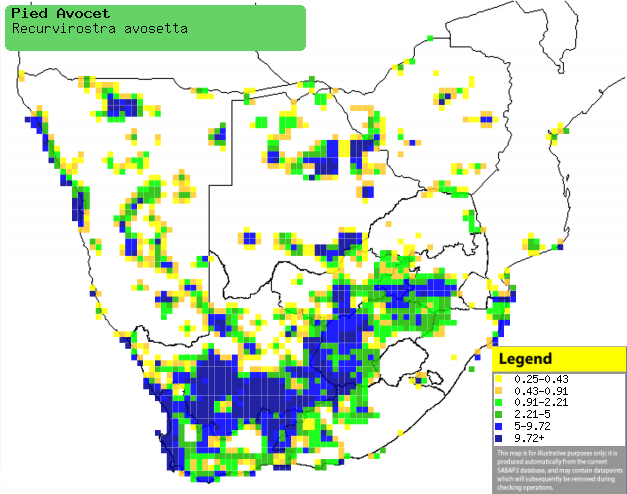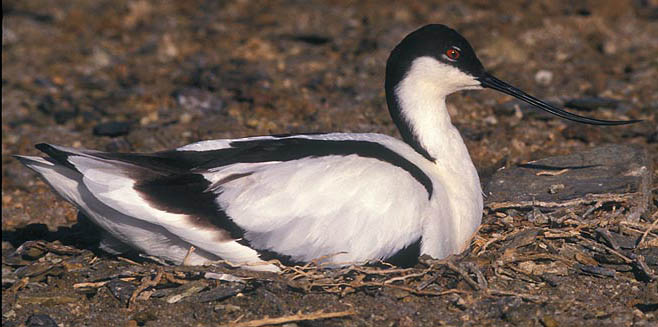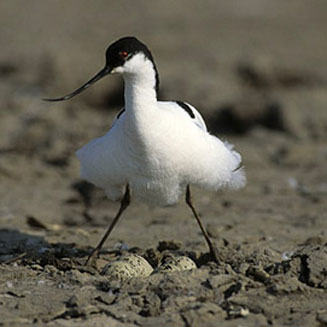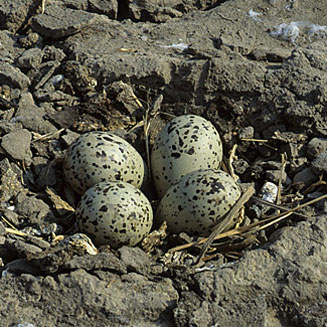|
Recurvirostra avosetta (Pied
avocet, Avocet)
Bontelsie [Afrikaans]; Kluut [Dutch]; Avocette élégante
[French]; Säbelschnäbler [German]; Alfaiate [Portuguese]
Life
> Eukaryotes >
Opisthokonta
> Metazoa (animals) >
Bilateria >
Deuterostomia > Chordata >
Craniata > Vertebrata (vertebrates) > Gnathostomata (jawed
vertebrates) > Teleostomi (teleost fish) > Osteichthyes (bony fish) > Class:
Sarcopterygii (lobe-finned
fish) > Stegocephalia (terrestrial
vertebrates) > Tetrapoda
(four-legged vertebrates) > Reptiliomorpha > Amniota >
Reptilia (reptiles) >
Romeriida > Diapsida > Archosauromorpha > Archosauria >
Dinosauria
(dinosaurs) > Saurischia > Theropoda (bipedal predatory dinosaurs) >
Coelurosauria > Maniraptora >
Aves
(birds) > Order: Charadriiformes
> Family: Recurvirostridae
Distribution and habitat
Occurs across much of the old world, from China and
Mongolia to Europe and sub-Saharan Africa, largely excluding the forests of the
DRC and West and East Africa. In southern Africa it is locally common in patches of Namibia,
Botswana, Zimbabwe, southern Mozambique and South Africa. It
generally prefers saline and temporary wetlands, as well as flood plains,
salt-marshes and sewage works.
|
 |
|
Distribution of Pied avocet in southern Africa,
based on statistical smoothing of the records from first SA Bird Atlas
Project (©
Animal Demography unit, University of
Cape Town; smoothing by Birgit Erni and Francesca Little). Colours range
from dark blue (most common) through to yellow (least common).
See here for the latest distribution
from the SABAP2. |
Predators and parasites
- Parasites
- Theromyzon cooperi (African duck leech)
Movements and migrations
Nomadic and partially migratory, moving in
search of areas which have experienced recent rainfall so that it
can stay at the resultant ephemeral pans.
Food
It mainly eats invertebrates, especially crustaceans and
Chironomid larvae, occasionally supplemented with fish. It typically forages tactilely, filtering and scraping food with its
head submerged, or using a technique in which swings its bill from side to side
in a scything motion. It may also locate prey visually and
pluck them from the water surface, alternatively dabbling in deeper water like a
duck. At Lake St. Lucia, KwaZulu-Natal, it was once
observed hunting soles (Soleidae).
Breeding
- Monogamous, usually solitary nester, although it sometimes breeds in loose
colonies of up to 100 pairs.
- The nest (see images below) is built by both sexes, consisting of a
simple scrape or animal footprint in the ground, untidily lined with
material such as small twigs, feather, scraps of vegetation and shells.
 |
|
Pied avocet at nest. [photo Peter Steyn
©] |
 |
 |
|
Pied avocet at its nest with eggs, Wakkerstroom,
South Africa. [photo Warwick Tarboton ©] |
Pied avocet eggs in nest, Wakkerstroom,
South Africa. [photo Warwick Tarboton ©] |
- Egg-laying season is year-round, generally peaking from June-October and
from March-April.
- It lays 1-4 eggs, which are incubated by both sexes for about 22-27
days.
- The chicks are led to the water soon after hatching and are cared for
both parents, taking their first flight at about 26-28 days old but
remaining with the adults well after fledging.
Threats
Not threatened.
References
-
Hockey PAR, Dean WRJ and Ryan PG 2005. Roberts
- Birds of southern Africa, VIIth ed. The Trustees of the John Voelcker
Bird Book Fund, Cape Town.
|
